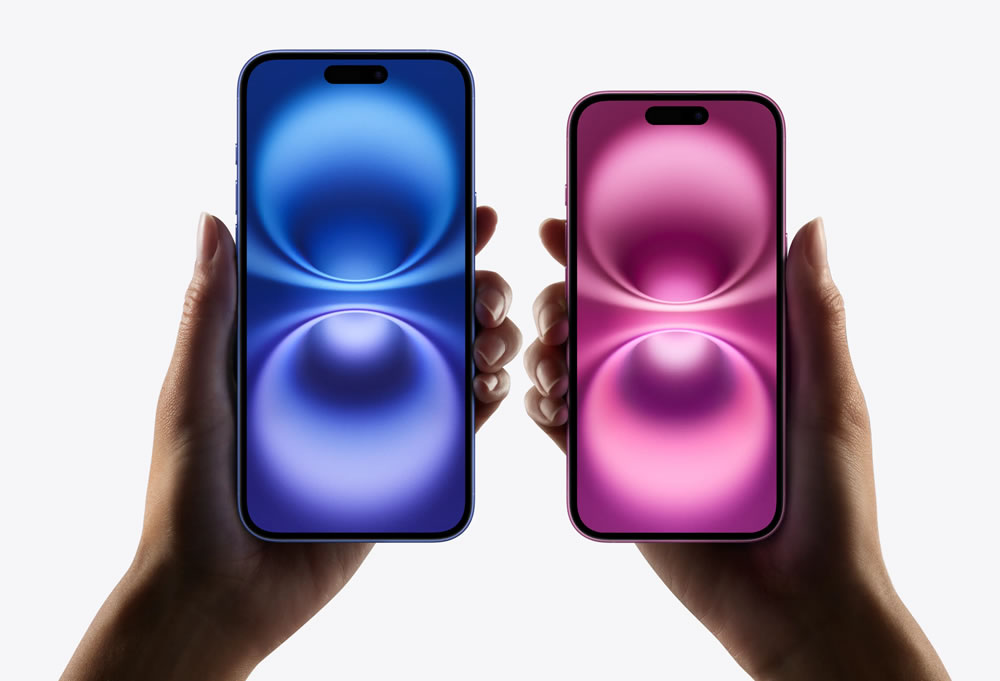
Above from left to right shows: iPhone 14 Pro Max, iPhone 14, iPhone SE (3rd gen).
Apple doesn’t make as many phones as the likes of Samsung or Xiaomi, but despite that there are a wide range of different iPhone sizes available. Just in the last few years for example Apple launched models that included the tiny 4.7-inch iPhone SE (2022) and the massive 6.7-inch iPhone 16 Pro Max.
Those two phones are clearly made with two very different buyers in mind, and the in between sizes will also suit different people. So which size – and phone – is best for you? Below we’ll look at all the modern options to help you make the right decision.
Which iPhone size is best for me?
Below we’ve divided Apple’s iPhone range into three different size categories – large, medium, and small. For each you’ll find things to consider when choosing both a size and a specific phone.
Large iPhones (6 inches and above)
|
iPhone model
|
Screen size / type
|
Dimensions / weight
|
|
iPhone 16 Pro Max (5G)
|
6.9-inch OLED with HDR10
|
163 x 77.6 x 8.3mm / 227g
|
|
iPhone 16 Plus (5G)
|
6.7-inch OLED with HDR10
|
160.9 x 77.8 x 7.8mm / 199g
|
|
iPhone 16 Pro (5G)
|
6.3-inch OLED with HDR10
|
149.6 x 71.5 x 8.3mm / 199g
|
|
iPhone 16 (5G)
|
6.1-inch OLED with HDR10
|
147.6 x 71.6 x 7.8mm / 170g
|
|
iPhone 15 Pro Max (5G)
|
6.7-inch OLED with HDR10
|
159.9 x 76.7 x 8.25mm / 221g
|
|
iPhone 15 Plus (5G)
|
6.7-inch OLED with HDR10
|
160.9 x 77.8 x 7.8mm / 201g
|
|
iPhone 15 Pro (5G)
|
6.1-inch OLED with HDR10
|
146.6 x 70.6 x 8.25mm / 187g
|
|
iPhone 15 (5G)
|
6.1-inch OLED with HDR10
|
147.6 x 71.6 x 7.8mm / 171g
|
|
iPhone 14 Pro Max (5G)
|
6.7-inch OLED with HDR10
|
160.7 x 77.6 x 7.9mm / 240g
|
|
iPhone 14 Plus (5G)
|
6.7-inch OLED with HDR10
|
160.8 x 78.1 x 7.8mm / 203g
|
|
iPhone 14 Pro (5G)
|
6.1-inch OLED with HDR10
|
147.5 x 71.5 x 7.9mm / 206g
|
|
iPhone 14 (5G)
|
6.1-inch OLED with HDR10
|
146.7 x 71.5 x 7.8mm / 172g
|
|
iPhone 13 Pro Max (5G)
|
6.7-inch OLED with HDR10
|
160.8 x 78.1 x 7.7mm / 240g
|
|
iPhone 13 Pro (5G)
|
6.1-inch OLED with HDR10
|
146.7 x 71.5 x 7.7mm / 204g
|
|
iPhone 13 (5G)
|
6.1-inch OLED with HDR10
|
146.7 x 71.5 x 7.7mm / 174g
|
|
iPhone 12 Pro Max (5G)
|
6.7-inch OLED with HDR10
|
160.8 x 78.1 x 7.4mm / 226g
|
|
iPhone 12 Pro (5G)
|
6.1-inch OLED with HDR10
|
146.7 x 71.5 x 7.4mm / 187g
|
|
iPhone 12 (5G)
|
6.1-inch OLED with HDR10
|
146.7 x 71.5 x 7.4mm / 162g
|
|
iPhone 11 Pro Max (4G)
|
6.5-inch OLED with HDR10
|
158 x 77.8 x 8.1mm / 226g
|
|
iPhone 11 (4G)
|
6.1-inch LCD
|
150.9 x 75.7 x 8.3mm / 194g
|
|
iPhone XS Max (4G)
|
6.5-inch OLED with HDR10
|
157.5 x 77.4 x 7.7 mm / 208g
|
|
iPhone XR (4G)
|
6.1-inch LCD
|
150.9 x 75.7 x 8.3 mm / 194g
|
The vast majority of modern iPhone models are over 6 inches in size. That’s unsurprising – smartphones in general are getting bigger with almost every passing year, and Apple’s are no exception, so the majority of modern iPhones can be found in this size range.
The biggest iPhone Apple has ever made is the 6.9-inch iPhone 16 Pro Max, closely followed by the 6.7-inch iPhone 16 Plus, iPhone 15 Pro Max, iPhone 15 Plus, iPhone 14 Pro Max, iPhone 14 Plus, iPhone 13 Pro Max, and iPhone 12 Pro Max, but there are also some 6.5-inch models such as the iPhone 11 Pro Max, and a number of 6.1-inch ones, such as the iPhone 16.
Opting for an iPhone in this size range means you’ll get a big screen of course, which is better for watching videos and viewing photos on than a small screen. If you’re a gamer it will also benefit you there, since the touch controls will be less cramped. And those benefits increase as you go up in size.
The main downside to a big iPhone is that it’s potentially too large to fully use with one hand – certainly, the likes of the iPhone 16 Pro Max will be for most people, and even the 6.1-inch models will be if you have smaller hands. You won’t be able to reach the top edge of the screen, meaning you can’t easily operate the phone while holding something in your other hand.
The large size also makes these phones slightly heavier and a bit less pocket-friendly – if you have small pockets and plan to keep your phone in them, you should check whether one of these iPhones will actually fit.
That said, all of these large models use a modern iPhone design, meaning either a notch or a camera cut-out at the top, but hardly any bezel otherwise. As such, there’s hardly any wasted space, so the overall dimensions aren’t as big as you might expect. In fact, the 6.1-inch models are overall smaller than some of Apple’s older 5.5-inch phones, which did have big bezels.
You can see the full dimensions for each of these big iPhones in the chart above, along with details of their screens.
Note that OLED screens are better than LCD ones, and that beyond that the newer iPhones typically have better screens than the older ones – so if you want the best possible quality, newer is generally better (though an older OLED will trump a newer LCD model). Support for HDR is also beneficial, as it makes HDR content look its best.
Of course, this website being 5G focused we’d be remiss if we didn’t also point out that of the large iPhones, everything from the iPhone 12 onwards supports 5G – so if you want the fastest (and most future-proofed) mobile data technology, you should definitely be considering one of them rather than an older model.
Medium iPhones (5 to 6 inches)
|
iPhone model
|
Screen size / type
|
Dimensions / weight
|
|
iPhone 13 Mini (5G)
|
5.4-inch OLED with HDR10
|
131.5 x 64.2 x 7.7mm / 141g
|
|
iPhone 12 Mini (5G)
|
5.4-inch OLED with HDR10
|
131.5 x 64.2 x 7.4mm / 133g
|
|
iPhone 11 Pro (4G)
|
5.8-inch OLED with HDR10
|
144 x 71.4 x 8.1mm / 188g
|
|
iPhone XS (4G)
|
5.8-inch OLED with HDR10
|
143.6 x 70.9 x 7.7mm / 177g
|
Apple used to make a lot of iPhone models in the 5 to 6-inch range, which we’re considering ‘medium’ size, but in remotely recent years it has only made four, so there’s a lot less to choose from here than if you want a large iPhone.
These for the most part are usable with one hand – particularly at the lower end of the size range, with the iPhone 13 Mini and 12 Mini being particularly one-hand friendly.
They’ll also more comfortably fit in smaller pockets, but this all comes at the expense of having an expansive screen to enjoy media on.
If you tend to use a phone mostly as a phone, have small hands, or often operate your phone while holding other things, then a model in this size range could make for an excellent choice, but they are all smaller than not just most other modern iPhones, but also most modern smartphones in general.
It’s worth noting additionally that the iPhone 13 Mini and iPhone 12 Mini are the only models in this size range that support 5G.
Small iPhones (under 5 inches)
|
iPhone model
|
Screen size / type
|
Dimensions / weight
|
|
iPhone SE (2022) (5G)
|
4.7-inch LCD
|
138.4 x 67.3 x 7.3mm / 144g
|
|
iPhone SE (2020) (4G)
|
4.7-inch LCD
|
138.4 x 67.3 x 7.3mm / 148g
|
In terms of modern iPhones with screens of under 5 inches, the only ones made in the last few years are the iPhone SE (2022) and the iPhone SE (2020). That’s a big change for Apple, which has many older phones in this size – but they’re old enough that we can’t really recommend them.
Both of these models of the iPhone SE have a 4.7-inch screen, which is absolutely tiny by modern standards, so they’re very easy to operate with one hand, but won’t be great for media. They’re all the worse on the media front because they use LCD, while other modern iPhones have OLED screens, which offer blacker blacks, and better contrast. There’s also no HDR support here. This however all keeps costs down, making the iPhone SE line the most affordable modern iPhones you can buy.
However, something else to bear in mind with them is that they sport Apple’s old design language (despite launching relatively recently). That means there are big bezels above and below the screen, which in turn mean the handsets as a whole are actually slightly larger than the iPhone 13 Mini or 12 Mini – though they’re still the second smallest modern iPhones.
It's worth noting also that while the iPhone SE (2022) supports 5G, the iPhone SE (2020) doesn’t.









